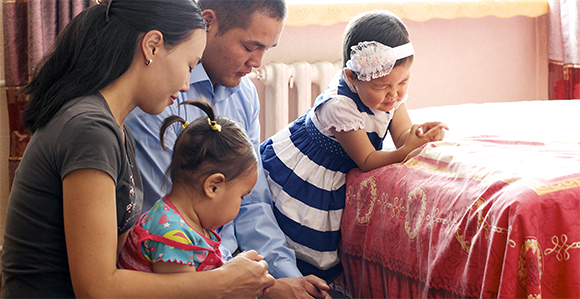Teach Children Proper Steps and Language for Prayer
Contributed By the Primary General Presidency and Board

Parents have the responsibility to help their children understand and incorporate the basic steps of prayer.
Article Highlights
- Help children understand and incorporate the four basic steps of prayer so their prayers will be more meaningful.
“Heavenly Father, are you really there? And do you hear and answer every child’s prayer?” (“A Child's Prayer,” Children’s Songbook, 12).
One day a young mother was holding her 1-year-old daughter’s hand, helping her to enjoy the newness of being upright and mobile. They came to a set of stairs. The little girl looked up at her mother in bewilderment. The mother said to herself, “Now would be a good time to teach this sweet girl how to go up and down stairs.”
She decided the best way to teach her was to show her. She got down on her hands and knees and put her face right next to her daughter’s so they could see eye to eye. She then showed her where to put her hands and knees as they practiced side-by-side going up and down the stairs. The mother and daughter celebrated each time they made it to the top of the stairs and again at the bottom.
A relationship with God
There are many steps our children need to learn to return to their Heavenly Father. The first of many steps is to teach them there is a God. He is a loving Heavenly Father who is anxious to have a personal, intimate relationship with them. Prayer is the key to this lifelong relationship. It opens up a spiritual line of communication that is essential, comforting, and eternal.
“Prayer is a gift from God,” Sister Carol F. McConkie, former member of the Young Women General Presidency, said during the October 2016 general conference. “We are never left alone to accomplish our work, to fight our battles, to face adversity or unanswered questions. … Every moment of precious prayer can be holy time spent with our Father, in the name of the Son, by the power of the Holy Ghost” (“The Soul’s Sincere Desire”).
Children learn through example
In the book of Enos we learn a great deal about prayer. Enos begins his story by telling us how much he admired and learned from his father, Jacob. He says, “He was a just man—for he taught me … in the nurture and admonition of the Lord … and the words which I had often heard my father speak … sunk deep into my heart.”
As Enos “wrestled” before God and his soul began to “hunger,” he knew from his father’s example the solution was to “[kneel] down before [his] Maker, and [cry] unto him in mighty prayer and supplication” (Enos 1:1–4).
Children are constantly watching how we handle our lives. If they see us get on our knees to receive heavenly help, perhaps, like Enos, their first instinct will be to get on their knees. Sister Joy D. Jones counseled in her April 2017 general conference talk, “Brothers and sisters, hold your little ones close—so close that they see your daily religious behavior. … ‘Children are great imitators, so give them something great to imitate’” (“A Sin-Resistant Generation”).
The four steps of prayer
By helping children understand and incorporate the four basic steps of prayer, their prayers will be more meaningful.
1. Our Father in Heaven
Prayer is a personal, spiritual closeness where we gain access to God, the Father of our spirits. He loves us and knows our needs. President Henry B. Eyring taught in a First Presidency message in the Ensign in September 2015 that our children will be blessed to “[know] early and to never forget that a loving God is as close as a prayer” (“Families and Prayer”).
2. We thank Thee
In Alma 34:38, Amulek counsels us to “live in thanksgiving daily, for the many mercies and blessings which he doth bestow upon you.” It is important for children to be grateful and to recognize how much their Father in Heaven has blessed them—even when it is not what they specifically asked for.
One parent had to explain this concept to his son, Charlie (age 4), when he prayed, “Thank you, Heavenly Father, for the baby brother, but what I really asked for was a puppy.”
3. We ask Thee
Prayer is a time to pour out your whole soul to God. It is a time to plead for understanding, comfort, and strength on your behalf and on behalf of those you love and care about.
Elder James E. Talmage eloquently described how to know what to pray for when he wrote, “Prayer is made up of heart throbs and the righteous yearnings of the soul, of supplication based on the realization of needs and pure desires” (Jesus the Christ, 226).
4. In the name of Jesus Christ, amen
We pray in the name of Jesus Christ because, as President Russell M. Nelson said in his April 2018 general conference address, “He is our Advocate with the Father, our Exemplar, and our Redeemer,” who is pleading your cause before Him (“Revelation for the Church, Revelation for Our Lives”).
In addressing a loving God, we should encourage children to use language that shows respect, love, and reverence for Him. The pronouns of the scriptures—such as Thee, Thou, Thy, and Thine instead of you, your, and yours—are a way to express our desire to have a respectful, worshipful relationship with our Father in Heaven.
In summary, much like the ascending steps in a home, prayer will help us ascend to our Heavenly Father and have an intimate, personal relationship with Him. Through prayer He will guide us. He will inspire us. He will answer our questions and the longings of our hearts (see “Revelation for the Church, Revelation for Our Lives”).
